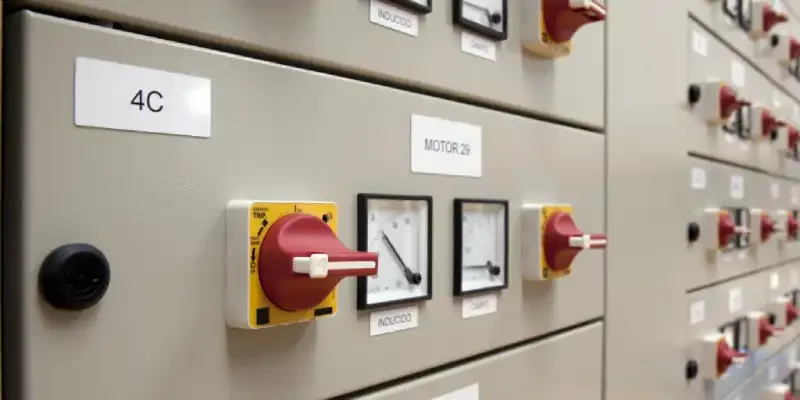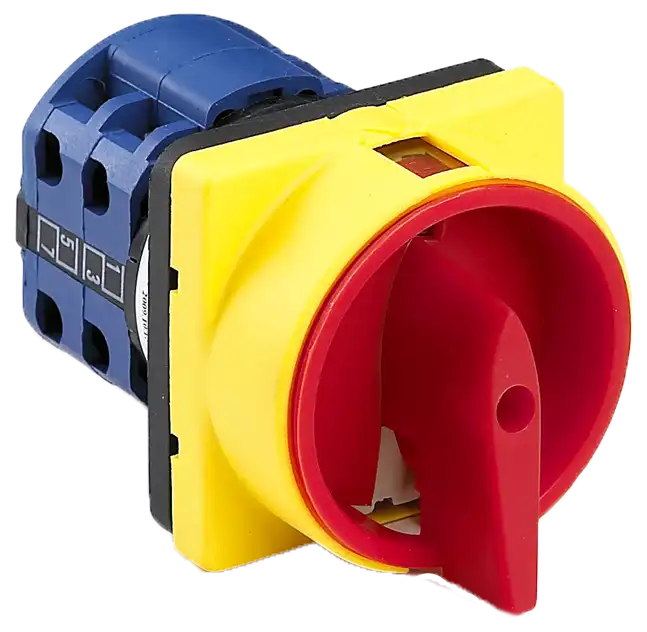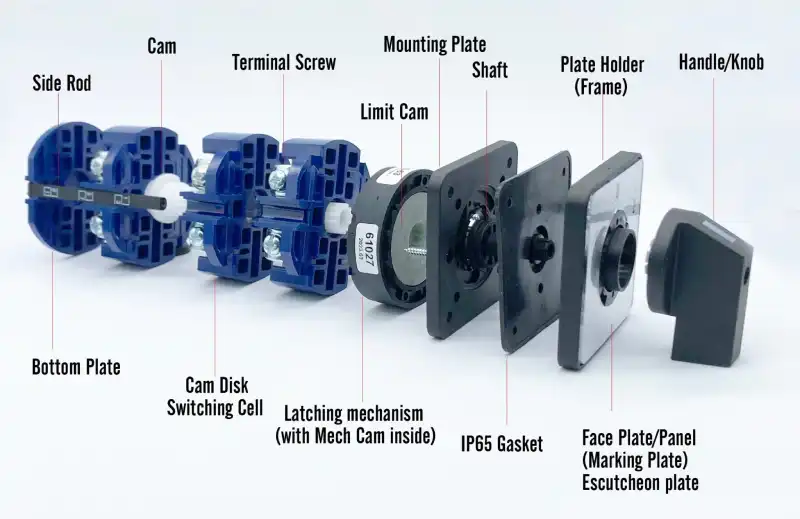I. Вступ
A. Визначення поворотних кулачкових перемикачів
Поворотні кулачкові вимикачі - це спеціалізовані електричні пристрої, призначені для керування кількома ланцюгами за допомогою одного перемикача. Вони працюють шляхом обертання вала, який зачіпає різні контакти, дозволяючи користувачеві встановлювати або розривати з'єднання між різними електричними ланцюгами. Ця функціональність дозволяє точно керувати складними електричними системами, що робить кулачкові перемикачі незамінними в різних сферах застосування - від промислового обладнання до побутових приладів.
Ось так виглядають перемикачі Rotary Cam:
B. Коротка історія та еволюція
Концепція поворотних вимикачів з'явилася на початку 20-го століття, розвиваючись разом з досягненнями в електротехніці. Спочатку для керування потоком електроенергії використовували прості механічні перемикачі. Згодом впровадження кулачкових механізмів уможливило більш складне керування, що дозволило розробити поворотні кулачкові вимикачі, які можуть керувати кількома ланцюгами з більшою надійністю та гнучкістю. Сьогодні кулачкові перемикачі виготовляються із застосуванням передових матеріалів і технологій, що забезпечують довговічність і ефективність у складних умовах експлуатації.
II. Як працюють поворотні кулачкові перемикачі
A. Базовий механізм
Поворотні кулачкові вимикачі працюють за допомогою простого, але ефективного механізму, що включає вал, який обертається. Коли вал обертається, він зачіпає кулачок, який переміщує внутрішні контакти, встановлюючи або розриваючи з'єднання між різними ланцюгами. Це дозволяє вимикачу керувати кількома функціями одним рухом. Механізм фіксації забезпечує тактильний зворотний зв'язок, вказуючи, коли перемикач перемістився в нове положення, підвищуючи зручність користування та точність роботи.
B. Ключові компоненти
- Кулачок: основний елемент, який обертається і контролює рух контактів.
- Контакти: Металеві деталі, які розмикають або замикають ланцюг; вони можуть бути сконфігуровані в різних варіантах залежно від конструкції вимикача.
- Вал: Частина, яку повертає користувач, щоб керувати вимикачем.
- Корпус: Зовнішній корпус, який захищає внутрішні компоненти та забезпечує структурну цілісність.
- Ручка/рукоятка
- Гвинти
C. Принцип роботи
Принцип дії поворотних кулачкових вимикачів заснований на механічному русі, який перетворюється на електричне керування. Коли користувач обертає вал:
- Зачеплення: Кулачок переміщується в різні положення, які відповідають певним конфігураціям ланцюга.
- З'єднання/роз'єднання: Коли кулачок обертається, він або з'єднує, або роз'єднує контакти, дозволяючи або перериваючи потік електроенергії.
- Універсальність: Конструкція допускає різні конфігурації, що дозволяє виконувати такі завдання, як перемикання між різними джерелами живлення або керування кількома пристроями з одного перемикача.
III. Типи поворотних кулачкових перемикачів
Поворотні кулачкові вимикачі призначені для різних застосувань, кожен тип виконує певні функції. Ось детальний огляд основних типів:
A. Стандартні поворотні перемикачі
Стандартні поворотні вимикачі в основному використовуються для простого вмикання та вимикання електричних пристроїв. Вони дозволяють користувачам легко з'єднувати або роз'єднувати ланцюги, повертаючи перемикач у різні положення. Ці вимикачі часто зустрічаються в побутових приладах і базовому промисловому обладнанні, забезпечуючи надійну роботу в найпростіших випадках.
B. Селекторні перемикачі
Селекторні перемикачі дозволяють користувачам вибирати між кількома режимами роботи або шляхами ланцюга. Обертаючи перемикач, користувачі можуть вибрати один з декількох підключених ланцюгів, що робить їх ідеальними для застосувань, які вимагають зміни джерел живлення або робочих налаштувань. Вони часто використовуються в панелях керування та механізмах, де потрібно активувати різні функції.
C. Багатоступеневі перемикачі
Багатоступінчасті перемикачі пропонують кілька різних положень, які відповідають певним функціям або налаштуванням. Ці перемикачі дають змогу точно контролювати різні робочі стани, що особливо корисно в додатках, які потребують поступового регулювання, наприклад, керування швидкістю обертання двигуна або регулювання яскравості освітлення. Їх конструкція дозволяє послідовно задіяти кілька ланцюгів.
D. Індивідуальні конфігурації
Нестандартні конфігурації поворотних кулачкових вимикачів розробляються відповідно до унікальних вимог застосування. Виробники можуть розробляти такі перемикачі з певною кількістю контактів і положень відповідно до потреб конкретної системи. Така гнучкість дозволяє створювати спеціалізовані рішення, які можуть керувати різними аспектами електричної системи з однієї точки, підвищуючи ефективність експлуатації.
E. Надміцні поворотні перемикачі
Поворотні перемикачі для важких умов експлуатації призначені для роботи в суворих промислових умовах. Вони забезпечують надійне механічне керування та виготовлені з міцних матеріалів, здатних витримувати високі струми та напруги, що гарантує надійність у складних умовах експлуатації.
F. Миттєві поворотні перемикачі
Миттєві поворотні перемикачі спрацьовують короткочасно при натисканні, дозволяючи користувачам вибирати ланцюг або миттєво перемикатися між увімкненим і вимкненим станом. Після натискання вони автоматично повертаються у стандартне положення, що робить їх придатними для тимчасового керування.
IV. Застосування поворотних кулачкових перемикачів
Кулачкові перемикачі - це універсальні пристрої, які використовуються в різних галузях промисловості для ефективного керування електрикою. Ось огляд їхніх ключових застосувань:
A. Промислове обладнання
Поворотні кулачкові перемикачі широко використовуються в промисловому обладнанні для керування різними функціями, такими як запуск, зупинка та регулювання швидкості двигунів. Вони незамінні в конвеєрних системах, пакувальних машинах і виробничих лініях, дозволяючи операторам легко контролювати послідовність операцій. Ця можливість підвищує продуктивність і безпеку, дозволяючи швидко ізолювати обладнання під час технічного обслуговування або в аварійних ситуаціях.
B. Системи опалення, вентиляції та кондиціонування
У системах опалення, вентиляції та кондиціонування повітря (HVAC) поворотні кулачкові перемикачі керують різними параметрами, такими як швидкість вентилятора та температура. Вони дозволяють користувачам ефективно налаштовувати режими роботи, сприяючи створенню комфортних умов у приміщенні. Точний контроль, який забезпечують ці перемикачі, гарантує оптимальну роботу систем опалення, вентиляції та кондиціонування відповідно до уподобань користувача.
C. Управління освітленням
Поворотні кулачкові вимикачі широко застосовуються в системах керування освітленням, надаючи користувачам можливість вибирати різні режими освітлення або регулювати рівень яскравості. Вони часто зустрічаються в диммерах і багатопозиційних системах освітлення, дозволяючи створювати індивідуальні світлові рішення в житлових і комерційних приміщеннях.
D. Розподіл електроенергії
У системах розподілу електроенергії поворотні кулачкові перемикачі забезпечують плавне перемикання між основним і резервним джерелами живлення. Вони відіграють важливу роль у забезпеченні стабільного енергопостачання для життєво важливих послуг, особливо в таких об'єктах, як лікарні та центри обробки даних, де надійність електропостачання має вирішальне значення. Ефективно керуючи розподілом навантаження, ці перемикачі допомагають запобігти збоям під час перебоїв в електропостачанні.
E. Автомобільні додатки
В автомобільній промисловості поворотні кулачкові перемикачі є невід'ємною частиною керування різними електричними системами в автомобілях. Вони використовуються в приладовій панелі, освітлювальних системах і системах опалення, вентиляції та кондиціонування, дозволяючи водіям легко регулювати такі параметри, як швидкість вентилятора і температуру. Ця функція покращує досвід користувача, забезпечуючи інтуїтивно зрозумілий контроль над роботою автомобіля.
V. Переваги використання поворотних кулачкових перемикачів
Поворотні кулачкові вимикачі мають кілька значних переваг, які роблять їх кращим вибором для різних застосувань. Ось ключові переваги:
A. Довговічність і надійність
Поворотні кулачкові вимикачі розраховані на тривалий термін служби і витримують жорсткі умови експлуатації. Міцна конструкція гарантує їхню надійність у складних умовах експлуатації, наприклад, на промислових об'єктах, де знос є поширеним явищем. Ці вимикачі витримують високі електричні навантаження, що робить їх придатними для важкої техніки, забезпечуючи надійну роботу протягом тривалого часу.
B. Універсальність конфігурації
Однією з визначних особливостей поворотних кулачкових перемикачів є їхня універсальність. Їх можна налаштувати відповідно до конкретних експлуатаційних потреб, що дозволяє створювати різні конфігурації, пристосовані до унікальних системних вимог. Така гнучкість дає змогу керувати різними аспектами системи з однієї точки, спрощуючи складні операції та зменшуючи потребу в декількох перемикачах.
C. Проста експлуатація
Поворотні кулачкові перемикачі зручні у користуванні та забезпечують просте керування. Користувачі можуть легко вибирати різні функції або шляхи ланцюга, просто повернувши перемикач у потрібне положення. Такий інтуїтивно зрозумілий дизайн підвищує зручність використання, дозволяючи операторам легко керувати електричними системами без спеціальної підготовки.
D. Економічна ефективність
Економічна ефективність поворотних кулачкових перемикачів зумовлена їхньою здатністю виконувати кілька функцій в одному пристрої, що зменшує потребу в додаткових компонентах. Їх довговічність також сприяє зниженню витрат на технічне обслуговування з часом, оскільки вони потребують мінімального догляду порівняно з іншими механізмами перемикання. Таке поєднання функціональності та довговічності робить їх економічно обґрунтованим вибором для різних застосувань.
VI. Вибір правого поворотного кулачкового перемикача
Вибираючи поворотний кулачковий перемикач, необхідно враховувати кілька важливих факторів, щоб переконатися, що він відповідає конкретним вимогам вашого застосування. Ось детальний посібник про те, що потрібно враховувати:
A. Міркування щодо відбору
- Вимоги до застосування: Визначте конкретні функції, які повинен виконувати вимикач, наприклад, керування двигунами, освітленням або багатоконтурними системами.
- Кількість положень: Визначте, скільки різних робочих станів повинен мати перемикач. Більша кількість положень дозволяє краще контролювати різні функції або ланцюги.
- Конфігурація контактів: Оцініть, скільки контактів потрібно та їх розташування, оскільки це визначатиме, що саме може контролювати перемикач.
B. Електричні характеристики
- Номінальний струм: Переконайтеся, що вимикач витримує максимальний струм, необхідний для вашої системи, не перегріваючись і не виходячи з ладу. Вибір комутатора з номінальним струмом, який відповідає або перевищує потреби вашої системи, має вирішальне значення.
- Номінальна напруга: Переконайтеся, що вимикач може безпечно працювати з напругою у вашій системі. Відповідний номінал напруги має важливе значення для запобігання електричних поломок і забезпечення безпечної роботи.
- Вимоги до живлення: Враховуйте будь-які специфічні вимоги до живлення, наприклад, для роботи від мережі змінного або постійного струму, і переконайтеся, що комутатор має відповідні номінальні характеристики.
C. Екологічні фактори
- Умови експлуатації: Оцініть умови навколишнього середовища, в якому буде встановлено комутатор, включаючи діапазони температур, рівень вологості та вплив пилу або вологи.
- Ступінь захисту від проникнення (IP): Вибирайте вимикачі з відповідним ступенем захисту IP для захисту від небезпек навколишнього середовища, особливо в промислових умовах, де часто трапляються несприятливі впливи.
- Довговічність: Шукайте вимикачі, виготовлені з міцних матеріалів, які витримують механічні навантаження та потенційні удари.
D. Параметри налаштування
- Індивідуальні конфігурації: Багато виробників пропонують варіанти налаштування, що дозволяють вам вказати такі характеристики, як тип ручки, розташування контактів і дизайн передньої панелі відповідно до ваших потреб.
- Модульні конструкції: Розглядайте комутатори з модульною конструкцією, яка дозволяє легко додавати або видаляти компоненти в міру того, як вимоги змінюються з часом.
- Спеціальні функції: Вивчіть варіанти спеціальних функцій, таких як ручки, що замикаються на замок для безпеки, пружинні механізми для миттєвих операцій або позолочені контакти для низькоенергетичних застосувань.
VII. Встановлення та обслуговування
Правильне встановлення та технічне обслуговування кулачкових вимикачів має вирішальне значення для забезпечення їхньої довговічності та надійної роботи. Ось вичерпний посібник:
A. Найкращі практики встановлення
- Ознайомтеся з інструкціями виробника: Завжди починайте з ознайомлення з інструкцією з монтажу, наданою виробником, для отримання конкретних вказівок і схем підключення.
- Визначте клеми: Знайдіть загальну клему на вимикачі, зазвичай вона позначена інакше, ніж інші. Це місце, де підключається джерело живлення.
- З'єднання проводки:
- Загальна клема: Підключіть провід від джерела живлення до загальної клеми, забезпечивши надійне з'єднання.
- Вихідні клеми: Приєднайте дроти до вихідних клем, що відповідають ланцюгам, якими ви хочете керувати. Переконайтеся, що всі з'єднання надійно затягнуті, щоб запобігти виникненню електричної дуги або перегріву.
- Монтаж: Надійно встановіть поворотний перемикач у призначений для нього корпус або панель, переконавшись, що проводка акуратно прокладена та ізольована, щоб уникнути короткого замикання.
- Фінальна перевірка: Перед увімкненням перевірте всі з'єднання, забезпечте належне заземлення, якщо необхідно, і протестуйте перемикач в роботі, щоб підтвердити його функціональність.
B. Поради з технічного обслуговування
- Регулярний огляд: Періодично перевіряйте вимикач на наявність ознак зносу, корозії або пошкоджень. Шукайте ослаблені з'єднання або фізичний знос.
- Очищення: Тримайте контакти чистими і вільними від сміття, оскільки накопичення бруду може погіршити роботу і призвести до перегріву. Використовуйте відповідні миючі засоби, рекомендовані виробником.
- Захист навколишнього середовища: Переконайтеся, що всі заходи захисту від пилу та вологи не порушені, особливо в суворих умовах експлуатації.
- Перевірка номінального навантаження: Регулярно перевіряйте, щоб вимикач працював у межах зазначених номінальних значень струму та напруги, щоб запобігти перевантаженню, яке може призвести до виходу з ладу.
C. Вирішення поширених проблем
- Нещільне прилягання ручки: Якщо ручка нещільно прилягає, це може бути пов'язано зі зносом внутрішнього валу. Часто цю проблему можна вирішити затягуванням регулювального гвинта або заміною ручки.
- Переривчасті з'єднання: Якщо вимикач не завжди забезпечує надійне з'єднання, причиною можуть бути зношені контакти. Очищення або заміна цих контактів може відновити функціональність.
- Вимикач, що не реагує: Якщо вимикач взагалі не працює, перевірте з'єднання проводів і огляньте внутрішні контакти на наявність пошкоджень або корозії. Може знадобитися перепідключення або заміна контактів.
VIII. Міркування щодо безпеки
A. Електробезпека
- Перед початком роботи знеструмте ланцюги; використовуйте процедури блокування/вимикання
- Вибирайте вимикачі з відповідними номінальними значеннями напруги та струму
- Забезпечте належне заземлення та ізоляцію
- Використовуйте ізольовані інструменти для ланцюгів під напругою
- Дотримуйтесь місцевих електротехнічних норм і правил
B. Належне поводження та експлуатація
- Прочитайте інструкцію виробника
- Уникайте перевантаження вимикачів
- Встановлювати в сухих приміщеннях
- Обережно поводьтеся з вимикачами під час монтажу
- Проводити регулярні тренінги з техніки безпеки для персоналу
X. Висновок
Поворотні кулачкові перемикачі є безцінними компонентами в системах електричного керування, пропонуючи універсальність, довговічність та ефективну роботу в різних галузях промисловості. Здатність керувати кількома ланцюгами за допомогою одного пристрою робить їх ідеальними для складних застосувань, від промислового обладнання до автомобільних систем. Розуміючи принцип дії, типи та критерії вибору, фахівці можуть використовувати весь потенціал цих перемикачів для підвищення безпеки, надійності та продуктивності електричних систем. З розвитком технологій кулачкові перемикачі продовжують еволюціонувати, зберігаючи свою актуальність у сучасних системах керування електрообладнанням.
XI. Часті запитання
A. Який термін служби типового поворотного кулачкового перемикача?
Термін служби типового поворотного кулачкового вимикача може варіюватися залежно від його конструкції та умов використання. Зазвичай ці вимикачі розраховані на 10 000 електричних циклів і 20 000 механічних циклів за нормальних умов експлуатації. Однак фактичний термін служби може бути значно довшим, якщо їх правильно обслуговувати та використовувати в межах зазначених номінальних параметрів.
B. Чи можна використовувати поворотні кулачкові перемикачі в небезпечних умовах?
Так, кулачкові вимикачі можна використовувати в небезпечних середовищах, якщо вони спеціально розроблені для таких умов. Багато виробників пропонують моделі з підвищеним ступенем захисту, наприклад, з класом захисту IP, який захищає від пилу та вологи, що робить їх придатними для використання в суворих промислових умовах або у вибухонебезпечних зонах. Дуже важливо вибрати вимикачі, які відповідають відповідним стандартам безпеки для передбачуваного небезпечного середовища.
C. Чим поворотні кулачкові перемикачі відрізняються від інших типів перемикачів?
Поворотні кулачкові вимикачі відрізняються від інших типів вимикачів насамперед своїм механізмом і функціональністю. На відміну від тумблерних або кнопкових вимикачів, які зазвичай керують одним колом або функцією, кулачкові вимикачі можуть керувати кількома колами за допомогою обертового механізму, який замикає різні контакти залежно від положення вимикача. Це дозволяє реалізувати більш складні сценарії керування, наприклад, перемикання між різними режимами роботи або керування кількома пристроями за допомогою одного перемикача.
D. Чи підходять кулачкові перемикачі для високовольтних застосувань?
Так, кулачкові перемикачі підходять для високовольтних застосувань, багато моделей розраховані на напругу до 690 В. Вони призначені для безпечного та ефективного керування значними електричними навантаженнями, що робить їх ідеальними для промислових застосувань, де висока напруга є поширеним явищем. Однак для забезпечення безпечної роботи важливо вибрати вимикач, який відповідає конкретним вимогам до напруги у вашому застосуванні.
Виробники поворотних кулачкових перемикачів
- Kraus & Naimer
- Заснована в Австрії в 1907 році, компанія є світовим лідером у виробництві кулачкових перемикачів.
- Веб-сайт: Kraus & Naimer
- Sälzer Electric Group
- Заснована в Німеччині в 1956 році, відома своїми надійними кулачковими перемикачами.
- Веб-сайт: Sälzer Electric Group
- BREMAS ERSCE S.p.A.
- Італійський виробник, відомий своїми сильними дизайнерськими можливостями.
- Веб-сайт: БРЕМАС
- Control Switches International Inc.
- Американська компанія, заснована жінками у 1957 році.
- Веб-сайт: Control Switches International
- VIOX
- Пропонує широкий вибір поворотних кулачкових перемикачів з можливістю кастомізації.
- Веб-сайт: VIOX
- Вперед, розподільчий пристрій.
- Різноманітні поворотні кулачкові перемикачі, пристосовані до різноманітних експлуатаційних потреб.
- Веб-сайт: Вперед, розподільчий пристрій.




